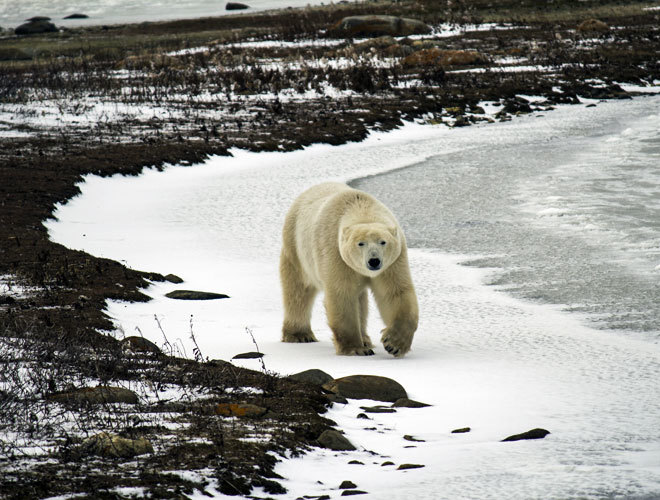Several populations of the Arctic predator are little studied, scientists say.

A large population of polar bears in Alaska and Canada has decreased by 40 percent since the start of the new millennium, new research shows.
The number of the large predators living in the southern Beaufort Sea plummeted from 1,500 animals in 2001 to just 900 in 2010, according to the study, published on November 17 in the journal Ecological Applications.
But there’s a lot we don’t know about the 18 other known polar bear populations, which are scattered throughout the U.S., Canada, Russia, Greenland, Norway, and Denmark, experts say.
For instance, nine groups, which live in places like northern Siberia, are little studied due to the remoteness of their locations and lack of funding.
Of the most studied populations, four—including the southern Beaufort group—are declining, five are stable, and one, in north-central Canada’s M’Clintock Channel, is actually increasing, scientists say.
The species as a whole is decreasing in number, and is listed as vulnerable by the International Union for the Conservation of Nature.
The reason for the variability in numbers is location, location, location.
“If you’re in the high Arctic, there’s a greater possibility of population stability [because] there is more ice pack and prey availability,” said David Koons, a National Geographic grantee who studies animal populations at Utah State University, in Logan.
On Thin Ice
The southern parts of the polar bear’s range, such as the southern Beaufort Sea, are warming faster than the northern regions and are thus more susceptible to melting sea ice.
As the ocean heats up due to global warming, Arctic sea ice has been locked in a downward spiral. Since the late 1970s, the ice has retreated by 12 percent per decade, and the decline has worsened since 2007, according to NASA.
It’s not surprising that the southern Beaufort Sea and its bears are feeling the effects first and more dramatically than those in more northern areas, said Ian Stirling, a biologist at the University of Alberta, in Edmonton, who is studying climate change’s impact on polar bears.
Polar bears in this region are declining because they use sea ice as hunting platforms to catch their primary prey, seals. But “when that ice is there, it’s really jumbled up [due to freezing and refreezing events],” said study leader Jeff Bromaghin, a U.S. Geological Survey statistician who studies wildlife population dynamics.
“The seals may be there, but [the polar bears] can’t get to them.”
In 2007, the U.S. Geological Survey estimated that the global polar bear population will shrink to a third of its current size by 2050, due to loss of habitat and less access to prey. From the Beaufort numbers, it looks like things are right on track, or perhaps even speeding up, according to Bromaghin.
“Nothing in this study contradicts the 2007 estimates,” said Bromaghin.
“Actually, observed loss of sea ice in the Arctic has been greater than earlier climate models. We’re losing ice faster than forecasted.”
Can Polar Bears Cope?
Faced with a less icy Arctic, some polar bears appear to be coping on land, in part by adding snow goose eggs and caribou to their diet.
For a species that needs fat-rich, energy-dense foods, though, a diverse palate might not be enough, according to Bromaghin.
“Sure, they’re starting to use land when food sources are limited. They’ll eat whatever they can catch. But it’s not enough to sustain them in the long run,” he said.
“Every scrap of evidence suggests that polar bears are linked to sea ice. There’s no evidence they can live on land.”
The fate of the species also remains unclear because so little is known about the understudied populations in the high Arctic, Utah State’s Koons noted.
Those bears may be in similarly dire straits, but it’s just undocumented, the University of Alberta’s Stirling pointed out.
“The fundamental concept is simple,” he said. “As we continue to lose ice, particularly during key feeding periods, numbers of polar bears will decline.
By Lubio Lenin Cardozo | Gustavo Carrasquel
Source news.nationalgeographic.com
Muy bueno, que has continuado tus luchas en otras latitudes. Me encanta el tema; porque aunque es muy conocido el tema poco los logros obtenidos en la no destrucción del habitat de los osos.
ResponderBorrar